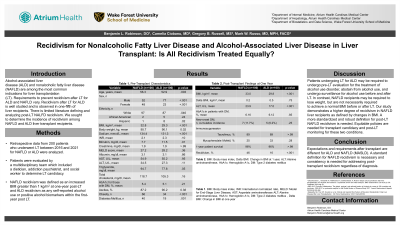Monday Poster Session
Category: Liver
P2402 - Recidivism for Non-Alcoholic Fatty Liver Disease and Alcohol-Associated Liver Disease in Liver Transplant: Is All Recidivism Treated Equally?
Monday, October 23, 2023
10:30 AM - 4:15 PM PT
Location: Exhibit Hall

Has Audio

Benjamin L. Robinson, DO
Atrium Health Carolinas Medical Center
Charlotte, NC
Presenting Author(s)
Benjamin L. Robinson, DO1, Camelia Ciobanu, MD1, Gregory B. Russell, MS2, Mark W. Russo, MD, MPH, FACG1
1Atrium Health Carolinas Medical Center, Charlotte, NC; 2Wake Forest University School of Medicine, Winston-Salem, NC
Introduction: Alcohol-associated liver disease (ALD) and nonalcoholic fatty liver disease (NAFLD) are among the most common indications for liver transplantation (LT). Requirements to prevent recidivism after LT for ALD and NAFLD vary. There is limited literature discussing the disparity in expectations after LT for NAFLD.
Methods: In this single-center retrospective study, we reviewed 200 patients who underwent LT between 2016 and 2021 for NAFLD or ALD. All ALD patients underwent evaluation by an addiction psychiatrist and social worker. Patients were evaluated by a dietician before LT and were required to have a body mass index (BMI) < 45 kg/m2. Pre-LT characteristics and indices of post-LT recidivism were compared. We defined post-LT NAFLD recidivism as increased BMI greater than 1 kg/m2 at one-year post-LT and alcoholic recidivism as any reported alcohol use or positive alcohol biomarkers post-LT.
Results: A consecutive sample of 100 cases for each group was analyzed. ALD patients were younger (52.9 vs. 56.3, p = .004) and more likely to be male (77% vs. 52%, p < .001). For ALD, 90% underwent LT for alcohol-associated cirrhosis and 10% for alcoholic hepatitis. A higher prevalence of pre-LT obesity (66% vs. 34%, p < .001) and pre-LT diabetes mellitus (40% vs. 19%, p = .001) accompanied those with NAFLD. Mean pre-LT BMI was higher for NAFLD recipients at 32.8 kg/m2 versus 29.3 kg/m2 (p < .001). Differences in BMI persisted at one-year post-LT with similar increases in BMI (NAFLD: 0.2 kg/m2, ALD: 0.5 kg/m2, p = .75). Pre-LT hemoglobin A1c levels among those with diabetes were similar between each group at transplant (p = .21) and at one year (p = .85). Most recipients had ascites before LT (NAFLD: 88%, ALD: 91%, p = .65). Pre-LT transaminases were similar between groups, but one-year post-LT the NAFLD group had higher alanine aminotransferase (23.9 vs. 17.0, p < .001). NAFLD patients had higher recidivism at 46% compared to the ALD group at 16% (p < .001).
Discussion: Patients undergoing LT for ALD may be required to undergo pre-LT evaluation for the treatment of alcohol use disorder, abstain from alcohol use, and undergo surveillance for alcohol use before and after LT. In contrast, NAFLD recipients may be required to lose weight, but are not required to achieve a normal BMI before or after LT. A standardized definition for recidivism in patients with NAFLD is needed in addition to equitable policies for transplant candidacy and post-LT monitoring for these two conditions.
Disclosures:
Benjamin L. Robinson, DO1, Camelia Ciobanu, MD1, Gregory B. Russell, MS2, Mark W. Russo, MD, MPH, FACG1. P2402 - Recidivism for Non-Alcoholic Fatty Liver Disease and Alcohol-Associated Liver Disease in Liver Transplant: Is All Recidivism Treated Equally?, ACG 2023 Annual Scientific Meeting Abstracts. Vancouver, BC, Canada: American College of Gastroenterology.
1Atrium Health Carolinas Medical Center, Charlotte, NC; 2Wake Forest University School of Medicine, Winston-Salem, NC
Introduction: Alcohol-associated liver disease (ALD) and nonalcoholic fatty liver disease (NAFLD) are among the most common indications for liver transplantation (LT). Requirements to prevent recidivism after LT for ALD and NAFLD vary. There is limited literature discussing the disparity in expectations after LT for NAFLD.
Methods: In this single-center retrospective study, we reviewed 200 patients who underwent LT between 2016 and 2021 for NAFLD or ALD. All ALD patients underwent evaluation by an addiction psychiatrist and social worker. Patients were evaluated by a dietician before LT and were required to have a body mass index (BMI) < 45 kg/m2. Pre-LT characteristics and indices of post-LT recidivism were compared. We defined post-LT NAFLD recidivism as increased BMI greater than 1 kg/m2 at one-year post-LT and alcoholic recidivism as any reported alcohol use or positive alcohol biomarkers post-LT.
Results: A consecutive sample of 100 cases for each group was analyzed. ALD patients were younger (52.9 vs. 56.3, p = .004) and more likely to be male (77% vs. 52%, p < .001). For ALD, 90% underwent LT for alcohol-associated cirrhosis and 10% for alcoholic hepatitis. A higher prevalence of pre-LT obesity (66% vs. 34%, p < .001) and pre-LT diabetes mellitus (40% vs. 19%, p = .001) accompanied those with NAFLD. Mean pre-LT BMI was higher for NAFLD recipients at 32.8 kg/m2 versus 29.3 kg/m2 (p < .001). Differences in BMI persisted at one-year post-LT with similar increases in BMI (NAFLD: 0.2 kg/m2, ALD: 0.5 kg/m2, p = .75). Pre-LT hemoglobin A1c levels among those with diabetes were similar between each group at transplant (p = .21) and at one year (p = .85). Most recipients had ascites before LT (NAFLD: 88%, ALD: 91%, p = .65). Pre-LT transaminases were similar between groups, but one-year post-LT the NAFLD group had higher alanine aminotransferase (23.9 vs. 17.0, p < .001). NAFLD patients had higher recidivism at 46% compared to the ALD group at 16% (p < .001).
Discussion: Patients undergoing LT for ALD may be required to undergo pre-LT evaluation for the treatment of alcohol use disorder, abstain from alcohol use, and undergo surveillance for alcohol use before and after LT. In contrast, NAFLD recipients may be required to lose weight, but are not required to achieve a normal BMI before or after LT. A standardized definition for recidivism in patients with NAFLD is needed in addition to equitable policies for transplant candidacy and post-LT monitoring for these two conditions.
Disclosures:
Benjamin Robinson indicated no relevant financial relationships.
Camelia Ciobanu indicated no relevant financial relationships.
Gregory Russell indicated no relevant financial relationships.
Mark Russo indicated no relevant financial relationships.
Benjamin L. Robinson, DO1, Camelia Ciobanu, MD1, Gregory B. Russell, MS2, Mark W. Russo, MD, MPH, FACG1. P2402 - Recidivism for Non-Alcoholic Fatty Liver Disease and Alcohol-Associated Liver Disease in Liver Transplant: Is All Recidivism Treated Equally?, ACG 2023 Annual Scientific Meeting Abstracts. Vancouver, BC, Canada: American College of Gastroenterology.

